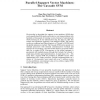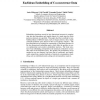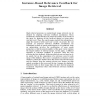100
click to vote
NIPS
2004
15 years 2 months ago
2004
Statistical approaches to language learning typically focus on either short-range syntactic dependencies or long-range semantic dependencies between words. We present a generative...
NIPS
2004
15 years 2 months ago
2004
We consider the semi-supervised learning problem, where a decision rule is to be learned from labeled and unlabeled data. In this framework, we motivate minimum entropy regulariza...
99
Voted
NIPS
2004
15 years 2 months ago
2004
We describe an algorithm for support vector machines (SVM) that can be parallelized efficiently and scales to very large problems with hundreds of thousands of training vectors. I...
100
click to vote
NIPS
2004
15 years 2 months ago
2004
In this paper we propose a novel method for learning a Mahalanobis distance measure to be used in the KNN classification algorithm. The algorithm directly maximizes a stochastic v...
NIPS
2004
15 years 2 months ago
2004
In this paper we propose an efficient algorithm for reducing a large mixture of Gaussians into a smaller mixture while still preserving the component structure of the original mod...
118
click to vote
NIPS
2004
15 years 2 months ago
2004
Embedding algorithms search for low dimensional structure in complex data, but most algorithms only handle objects of a single type for which pairwise distances are specified. Thi...
109
Voted
NIPS
2004
15 years 2 months ago
2004
High retrieval precision in content-based image retrieval can be attained by adopting relevance feedback mechanisms. These mechanisms require that the user judges the quality of t...
129
click to vote
NIPS
2004
15 years 2 months ago
2004
Saliency mechanisms play an important role when visual recognition must be performed in cluttered scenes. We propose a computational definition of saliency that deviates from exis...
94
Voted
NIPS
2004
15 years 2 months ago
2004
Clustering and prediction of sets of curves is an important problem in many areas of science and engineering. It is often the case that curves tend to be misaligned from each othe...
NIPS
2004
15 years 2 months ago
2004
The computation of classical higher-order statistics such as higher-order moments or spectra is difficult for images due to the huge number of terms to be estimated and interprete...



